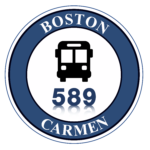400 Million Rides: MBTA Ridership Hit A Record High In 2014
March 10, 2015
WBUR | By ZENINJOR ENWEMEKA | March 10, 2015

People boarding a Blue Line train.
BOSTON, MA—With increased rides on the subway, buses and the commuter rail, the MBTA had a record 400.8 million trips last year — putting the transit system in line with a nationwide trend in which more and more people are using public transportation.
A new report released Monday by the American Public Transportation Association (APTA) found Americans are using public transportation in record numbers. Across the U.S. there were 10.8 billion trips made using public transportation in 2014, up from 10.7 billion in 2013 and 10.5 billion in 2012. It’s the highest ridership in 58 years, according to the transit advocacy organization.
APTA attributes the ridership increase to growing demand for public transit and economic gains in certain areas. The report also shows the use of public transit increased despite falling gas prices last year.
“Truthfully, what’s going on is people across the country are now changing their travel behavior,” APTA spokeswoman Virginia Miller said in a phone interview. “One thing we’ve seen a lot really since 2005 is that when gas prices really shot up, we saw more and more people choosing to take public transportation and parking their car. That’s been going on for quite a while. The interesting thing is once people start a new habit and they try a bus or a train, when gas prices go down, people don’t leave transit because they’ve found there’s other reasons to take public transit — like not being caught in congestion on Storrow Drive as an example.”
The report analyzed 228 transit systems across the U.S. using data provided by transportation agencies for the 2013 and 2014 calendar years.
MBTA ridership in 2014 totaled 400.8 million trips, a 1.8 percent increase (or 7 million trips) from 2013, which had 393.8 million total trips. T ridership in 2014 was the highest recorded in MBTA history, according to T spokesman Joe Pesaturo. That’s despite declining gas prices and a 5 percent MBTA fare hike that took effect in July.
Pesaturo said ridership grew on every mode of transit in the MBTA system except for the Green Line.
“The temporary closure of Government Center Station most certainly had an impact on Green Line ridership,” Pesaturo said in an email.
The APTA report shows a 4.01 percent decrease in ridership on the MBTA’s light rail service (Green Line), from 72.3 million in 2013 down to 69.4 million in 2014. Nationally, light rail (trolleys, streetcars, etc.) ridership increased 3.6 percent in 2014.
T subway service increased by 4.89 percent with 174.8 million rides in 2014, compared to 166.7 million in 2013. Nationally, subway service increased 3.3 percent. Meanwhile, MBTA bus service increased by 1.6 percent with 115.6 million rides in 2014, compared to 113.8 million in 2013. Nationally, bus ridership declined by 1.1 percent.
The report also found an increase in ridership on the MBTA’s commuter rail, which was up 3.5 percent in 2014 with 36.1 million rides, compared to 34.9 million rides in 2013. The commuter rail was hit hard by delays and cancellations this winter and has had declining ridership for the past decade.
Ridership also increased on the T’s ferry boat system by 9.54 percent (1.38 million in 2014 compared to 1.26 million in 2013) and its paratransit services, The Ride, by 2.11 percent (from 2.09 in 2013 to 2.13 million in 2014).
The high numbers for the MBTA come after weeks of transportation failures as the beleaguered system struggled during this year’s historic winter.
“Prior to this year’s stormy winter, the MBTA had been providing customers with service that was an ideal alternative to automobile travel,” Pesaturo said in an email. “In addition to providing more reliable service in 2014, the MBTA increased service on commuter rail and certain bus routes. It’s also clear that the availability of smartphone apps with real time information has made MBTA services increasingly popular.”
Boston’s increased ridership could also be attributed to economic development, according to the APTA.
“We see the economic impact that’s connected to public transportation, so you have also employers and employees want to come to Boston because they can get back and forth to their job in an easier manner as opposed to some other areas that might not have as extensive or mature public transportation system,” said Mantill Williams, APTA’s director of advocacy communications.
The report also found record ridership in other cities such as Denver, San Francisco, Minneapolis, Seattle, Albany, New York and Tampa, Florida.
Williams said the report shows the need for Congress and local legislatures to provide long-term investment in public transportation systems — an issue that has bubbled up this winter after all the MBTA troubles.
“We need long-term investment in our public transportation infrastructure because without that we can’t plan projects, we can’t maintain our systems … particularly systems like Boston — we can’t bring our systems up to a state of good repair,” he said. “When we look at the numbers as an industry, we see over…$88 billion in backlogs just to bring our systems up to a state of good repair, and Boston is a big part of that because Boston’s one of the first transit systems.”
The APTA also releases quarterly ridership numbers. After this winter, it’s likely the MBTA ridership numbers will take a hit for the first quarter of 2015.


Recent Comments